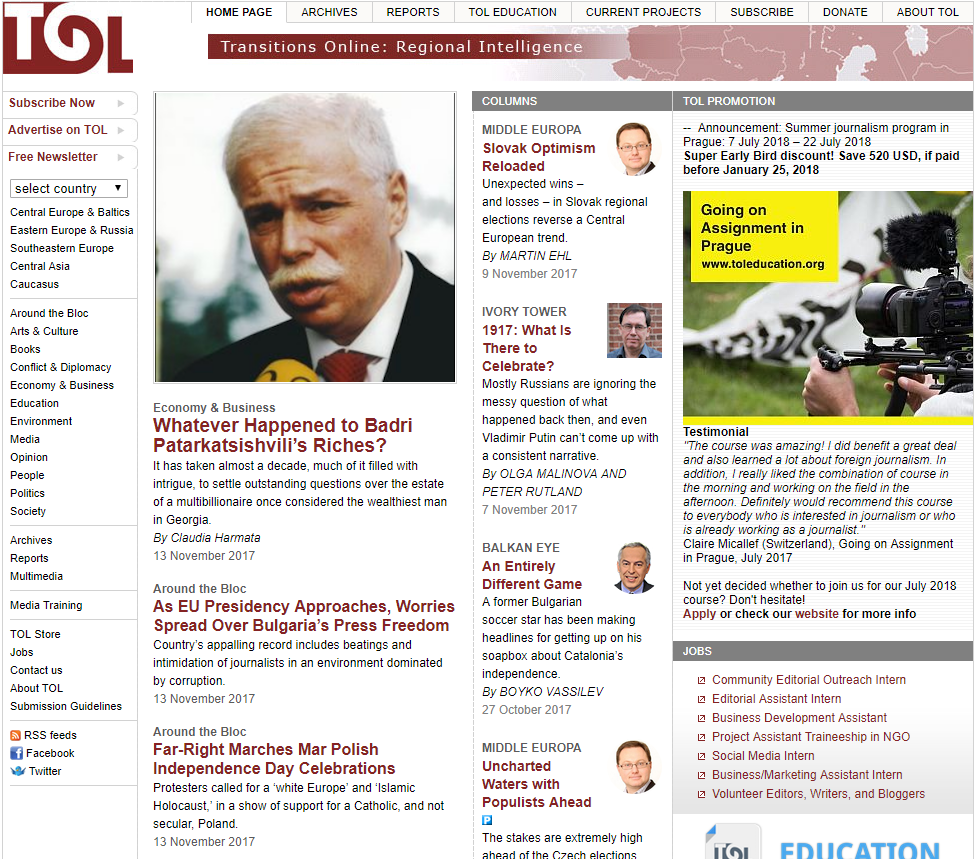
Transitions Online_Around the Bloc-Georgian, Russian Church Leaders Discuss Abkhaz Schism
Georgia and Russia have no diplomatic relations, but their Orthodox churches remain on friendly terms.
More...We kindly inform you that, as long as the subject affiliation of our 300.000+ articles is in progress, you might get unsufficient or no results on your third level or second level search. In this case, please broaden your search criteria.

Georgia and Russia have no diplomatic relations, but their Orthodox churches remain on friendly terms.
More...
The author examines the issue of religious partition of the Serbian people from the Middle Ages until the 1930s. Division along the religious lines may be generally observed everywhere on the territory inhabited by the Serbs. Yet, the author decides for the most part to focus on the Serbs of Dalmatia, Dubrovnik and Boka Kotorska in the XIX and at the beginning of the XX century, and on their adherence to either Orthodox, or Roman-Catholic Christianity. The religion could have played both the consolidating and the disintegrative role in formation of the Serbian nation, and the author explores these options, studying the beliefs and convictions of two prominent Serbs of the time: Roman-Catholic Marko Murat and Orthodox bishop Nikodim Milaš. In the end, the author deliberates on three Serbian misapprehensions with respect to the relation between the religion and the Serbian nation.
More...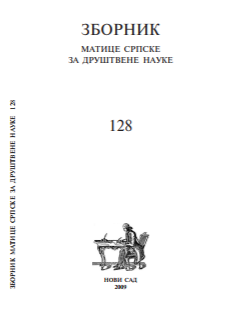
The text analyzes the addressing of letters sent to Melentije Pavlović at the time when he was the Archbishop of Belgrade and Metropolitan of Serbia, 1831—1833. The paper also analyzes the introductory sentences in the letters and greetings, expressions of respect of the applicants and other correspondents.
More...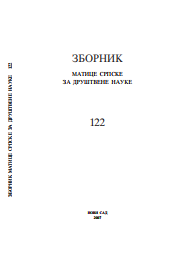
Activity of the Serbian Orthodox Church during the enslavement under the Turks was of decisive and invaluable significance for maintaining the national spirit of the Serbian nation in the region of the Old and South Serbia. The construction of monasteries and temples, as the centres of Serbian spirituality, was the primary goal of The Serbian Orthodox Church and The Government of The Kingdom of Serbia. Kosovska Mitrovica is a small town which got its Orthodox church last. The construction of the church (1896–1921) went slowly, depending on the political and economic (mis)happenings. Anger of the Albanians, obstinacy of the Turks, two Balkan and one world war dictated the speed of the construction of the church. The project of the church (Andra Stevanović) and of the bell-tower (Aleksandar Deroko) was also economically expensive. The executor(s) of the work, master masons from Veles and painters from Macedonia were also expensive. The church was built with the great effort of The Church Muncipality and it was the spiritual centre of the Serbs in Kosovska Mitrovica and its surroundings between the two world wars. The Temple of St. Sava celebrates a great jubilee on August 6, 2007 – the 110th anniversary from the beginning of its construction. The Serbs do not live in the socalled South Mitrovica, where the church, the bell-tower, the chapel and the cemetery are locadet. From the distance of 500 meters, the Serbs from Northern Mitrovica watch the burnt temple, destroyed chapel and broken monuments in the southern part of the town, waiting for the new construction of the church, of the chapel, of the cemetery...
More...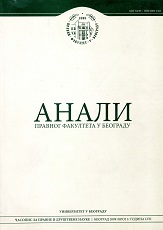
The main objective of this article is to examine the intricate processes of emancipation of the Serbian Church from the control of the State; which occurred under the rule of Prince Miloš, and was institutionally defined in 1836, by the Act on Ecclesiastical Powers. The Archbishop Petar proposed – and the Council accepted – the wording of the Organizational Structure of Ecclesiastical Power, which transferred the matter of organization of religious affairs to the previously neglected ecclesiastical authorities. This was achieved by the Archbishop’s astute use of the political visions of both the Constitutionalists and Prince Aleksandar and their intention to reform and direct Serbian society towards Europe by means of a series of systemic measures.
More...
The main principles of cultural-art in general and music programs in particular are mirrors of the spiritual processes of society and as a whole of the state, the nation, the region in the formation of a certain public opinion. In the twentieth century, these processes were sometimes not very clear, and were hidden under the mask of external conditionalities. It refers to the ability of society to play and animate existing meanings of cultural tradition in order to modern historical and social conditions.Synthesis is one of the fundamental principles of the Orthodox monastic culture, which follows from the theology that postulates the need for restoration of all persons, world and society that are on the state of division. The phenomenon of the synthesis in the Orthodox monastic culture is the embodiment of Truth in different languages (verbal and nonverbal, iconic, functional, conventionally, etc.).
More...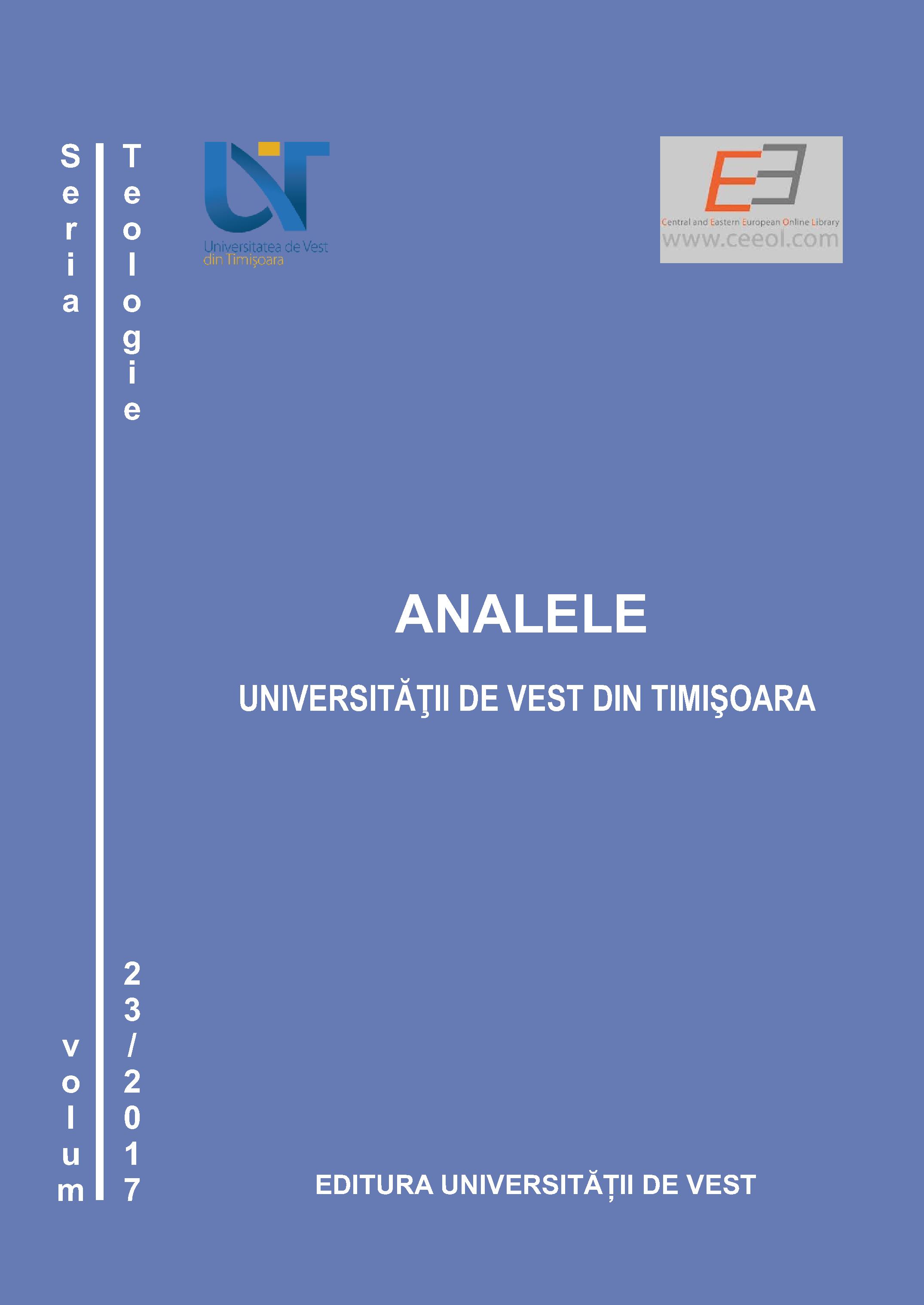
Une étude sur le lexème biblique (gr.) akatharsía dans le contexte des épîtres de Saint Paul. L'auteur soutient que Saint Paul emprunte (gr.) akatharsía au judaïsme hellénistique comme signifiant «l'aliénation de Dieu», ne négligeant pas entièrement la signification rituelle du mot («impureté, impureté»). On peut parler d’une transition vers une vision plutôt morale et spirituelle du lexème en discussion. Comme nous pouvons le voir, dans les écrits de Saint Paul l'impureté est comprise comme un acte de la chair, elle est une expression de la nature de l'être humain déchu dont les actions sont déterminées par l'engagement, non à Dieu, mais à ses instincts naturels.
More...
The gift of discernment is a special quality of the Desert Fathers. An elder has the gift of discernment, namely he is able to recognize the true character of ascetics he encounters. The cultivation of this virtue was a central element in the spirituality of the desert.
More...
In Romania, religious education is included in all pre-tertiary studies: primary, secondary, high school and vocational education. It was first included in the Public Instruction Law (1864). However, religious education was eliminated from these structures with the establishment and ruling of the communist totalitarian regime (1948-1989). Since 1989, religious education has been reinstated in public schools, initially under protocols between the Education Ministry and the religious cults officially recognised. Later, the Romanian State emitted several normative acts referring to this issue: the Constitution (1991), Education Law no. 84/1995, National Education Law no. 1/2011, the Cults Law no. 489/2006. Each recognized cult can organise doctrine-specific religious education, in both public or private schools. Therefore, students have the constitutional right to participate in religious classes, according to their own religious beliefs. Students may be able to not attend these classes either via their own written application (if they are adults) or their guardians (if they are minors). The ”Religion” discipline can be taught only by qualified education staff, in conformance with current legal norms, enabled on the basis of protocols between parties.
More...
Today, when the Romanian society has reached a real crisis caused by the loss of the authentic moral values and when the religious attitude fades away, especially when we think of the decisions taken by the public institutions and not only, decisions which influence people's life, the Church shows that It is ready to keep the communion and its final beneficiary - the citizen. A relationship as such is based on the common faith in God.
More...
Lord Jesus Christ came into the world as Light, so that “whosoever believeth on Him should not abide in darkness” (John 12, 46). The children of Light receive His words as food and taste of the eternal life, as “man shall not live by bread alone, but by every word that proceedeth out of the mouth of God” (Matt. 4, 4).
More...
Ion Vidu, one of the most famous Romanian composers from Banat, composed a type of choral sacred music remarkable by a simplicity that denotes, at a second glance, not a limitation of its compositional capabilities but a real desire to connect them to the authentic aesthetic values of Orthodox music. The present study proposes a journey into the universe of Vidu's aesthetic concepts, viewed from the forefront of his efforts to create a music that corresponds to the real needs of the common liturgical song.
More...
The article considers the problem of Orthodox Church of the Moscow patriarchy restoration of activity in Donetsk region in 1988—2004. Chronologically this period covers events, since the solemn celebration of the 1000 anniversary of the Christianization of Kievan Rus and before assignment of the status of the Laura to the Svyatogorsk monastery that had crucial importance for Donetsk region. The main content of the research makes synthesis of theoretical information about the concrete steps taken by Church on the way of its influence restoration in the region. The author accentuates the main administrative transformations and gives a short characteristic to the local religious leaders as well as to a number of events held in Donetsk region during the specified period. Traced is the formation of the Orthodox Church as one of important social institutes. A number of the sources stored in the Donetsk archive are introduced and incorporated into the research for the first time.
More...
Catholicism, ecumenism. In 2016 in social and political as well as in theological and intellectual service of the Russian Orthodox Church of Moscow patriarchy (ROC MP) has occurred two sign and at the first reading opposite events in a social mainstream. It is, first, about the historical meeting of the Patriarch of Moscow and all Russia Kirill and the Pope Francis which took place on the 12th of February in the building of the international airport named after Jose Marty in the capital of Cuba — Havana; secondly, about non-participation of the delegation of ROC MP in the All-Orthodox cathedral which was held in June in Crete. The expectation of these meetings lasting infinitely in historical time, preparation for them, the content of the dialogue, which was and was not held, the reaction which is emotionally painted post factum as in secular and church society, and in the first stage in the environment of the church intelligentsia deserve the historical and theological analysis and a reflection, as is the subject of this article.
More...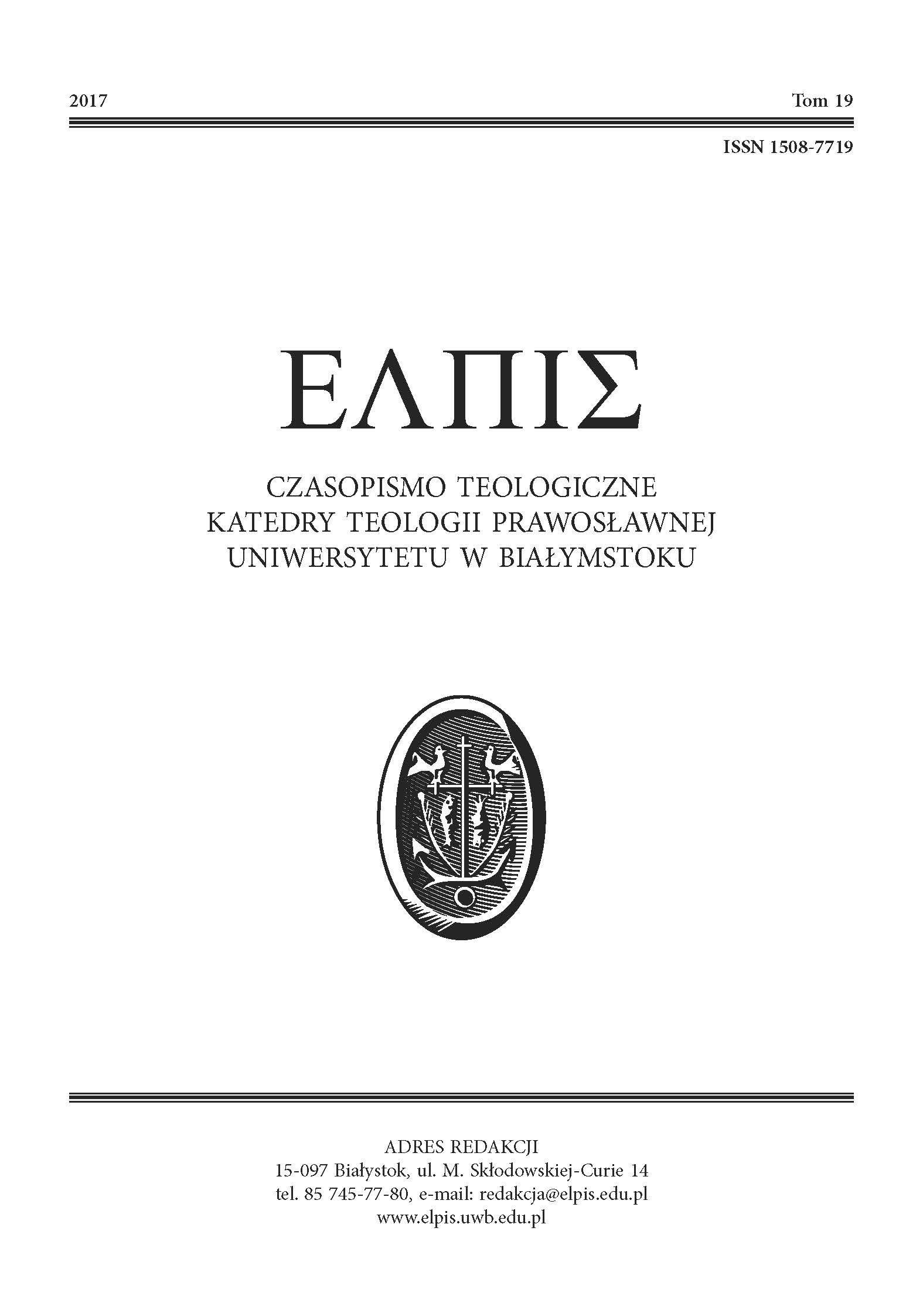
The abandonment of traditions of patriarchy took place in Russia on beginnings of the 17th century. Decision of the tsar Peter I to appoint the collegial The Most Holy Governing Synod headed by Ober-Procurator became an object of disputes between supporters and opponents of the patriarchy. Discussions on the role and the place of the patriarch in the structure of the Russian Church were conducted during session of a Preconciliar Commission (1906-107) and The All Russian Sobor (1917-1918), restoring the dignity of the first bishop and ending polemics taken in this subject. This paper is an attempt to approximate opposing positions. Through analysis of speeches of active participants of these assemblies was shown the diversity of evoked arguments of historical and canonical and contemporary needs of community.
More...
In the second half of 16th century in the Grand Duchy of Lithuania started to come into existence brotherhoods of an Orthodox church. Promoting education amongst members of the Orthodox church was one of directions of their activity. In this subject an Orthodox brotherhood played the crucial role in Mogilev. The article is describing activity of the orthodox brotherhood in Mogilev concentrating mainly on his educational activity: of history of the brotherhood’s school, her articles of association, teachers, objects lectured on, recordings of burgesses for the school.
More...
The article examines non-canonical organizations of believers, communities and dioceses that are part of the non-canonical Orthodox jurisdictions operating on the territory of the Novosibirsk Metropolitanate of the Russian Orthodox Church of the Moscow Patriarchate located within the borders of the Novosibirsk Region of the Russian Federation. Despite the sharp rejection of the legitimate church structure, these communities could not draw attention to their activities on the part of broad layers of Orthodox believers in the Novosibirsk region and are in a state of canonical isolation, periodically changing their jurisdictional affiliation.
More...
The article exemplifies the teaching of the Pomeranian Old Believers in relation to the Orthodox chant, in particular its forms practiced by this community. The author tries to indicate the essence of reluctance of the Old Believers towards new Orthodox melodies. In order to do so, he critically analyses available historical sources, especially he focuses on extracts concerning the Orthodox chant written in 1723 on Wyg, in theological treaty Pomorian Answers (18th century manuscript) . The author presents changes of the 17th century chant as one of the reasons of division of the Moscov Orthodox Church.
More...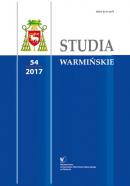
The article is devoted to the peculiarities of the image of the horses in the iconographic plots. The author outlined the main ways to classify these animals in the Eastern European tradition of icon painting. The division of horses depends on the relationship and environment (transcendent or immanent) in which they have been depicted on the icons. Conducted a series of semantic parallels that demonstrate mapping latent connections (orthodox religion and national perception) in the iconography XII-XVIII centuries.
More...
When analyzing the contemporary Orthodox liturgical tradition, we will hardly find in it silent. This article is to show that this element is not unfamiliar in the Orthodox liturgics and that it has its place and its purpose.
More...